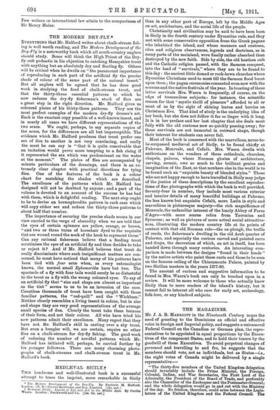MEDIEVAL SICILY.f
This handsome and well-illustrated book is a successful attempt to trace the imprint, more remarkable in Sicily • The Modern Development of the Dry-Fly. By Frederic 11. Raiford. London: (N. D.) George Boutledge and Son, Limited. [15s. net.] t Medizral Aspects of Life and Art in the Middle Agee. By Cecilia Waern. London : Duckworth and Co. [12e. 6d. net.]
than in any other part of Europe, left by the Middle Ages on art, architecture, and the social life of the people.
Christianity and civilisation may be said to have been born in Sicily in the fourth century under Byzantine rule, and they met with some conservative opposition from the Greek pagans who inhabited the island, and whose manners and customs, rites and religious observances, legends and doctrines, as in many parts of the mainland, were finally rather absorbed than destroyed by the new faith. Side by side, the old heathen cult and the Catholic religion passed, with the Saracen conquest, into the land of " survivals," where they are to be found to this day : the ancient little domed or rock-hewn churches where Byzantine Christians used to meet till the Saracen flood burst upon them ; the pagan ceremonies connected even now with the seasons and the native festivals of the year. In treating of these latter survivals Mrs. Waern is frequently, of course, on the edge of tremendous subjects : for instance, the scientific reason for that " mystic thrill of pleasure" afforded to all or most of us by the sight of shining leaves and berries on Christmas Eve. That kind of study is the underlying idea of her book, but she does not follow it far or linger with it long. It is in her preface and her last chapter that she deals most fully with the old customs now so quickly passing away ; for these survivals are not immortal in outward shape, though their interest for students can never fail.
Most of the book is concerned with the marvellous, never-to- be-surpassed medisval art of Sicily, to be found chiefly at Palermo, Monreale, and Cefalir. Mrs. Waern dwells with enthusiasm on the wonders of those cathedrals, churches, chapels, palaces, whose Norman glories of architecture, carving, mosaic, owe so much to the brilliant genius and imagination of the East, so that nowhere else in the world is to be found such an " exquisite beauty of blended styles." Those who are not happy enough to have travelled in Sicily may judge of the justice of these descriptions by the excellent reproduc- tions of fine photographs with which the book is well provided. Seventy-four in number, they include most various exterior and interior details of many beautiful buildings at Palermo, the less known but exquisite Cefahi, more Latin in style and marvellous in picturesque majesty—the rich magnificence of Monreale, the unfamiliar interest of the lonely Abbey of Forza d'Agro—with more scarce relics from Taormina and Syracuse ; as well as pictures of more actual social attractive- ness, illustrating the modern country life at its points of contact with that old Norman rule—the ox-plough, the trellis of reeds, the fisherman's dwelling in the old Arab quarter of Palermo, and especially the curious carved and painted carts and drays, the decoration of which, an art in itself, has been banded down through many centuries. An interesting com- parison is made between the designs "found in their heads " by the native artists who paint these carts and those to be seen on the famous ceiling of the Chiaramonte Palace, painted by two Sicilian masters in the years 1377-80.
The amount of curious and suggestive information to be found in Mrs. Waern's book can only be touched upon in a review. It will be more welcome to those who actually know Sicily than to mere readers of the island's history, but it cannot fail to interest all who care for early art, archaeology, folk-lore, or any kindred subjects.










































 Previous page
Previous page